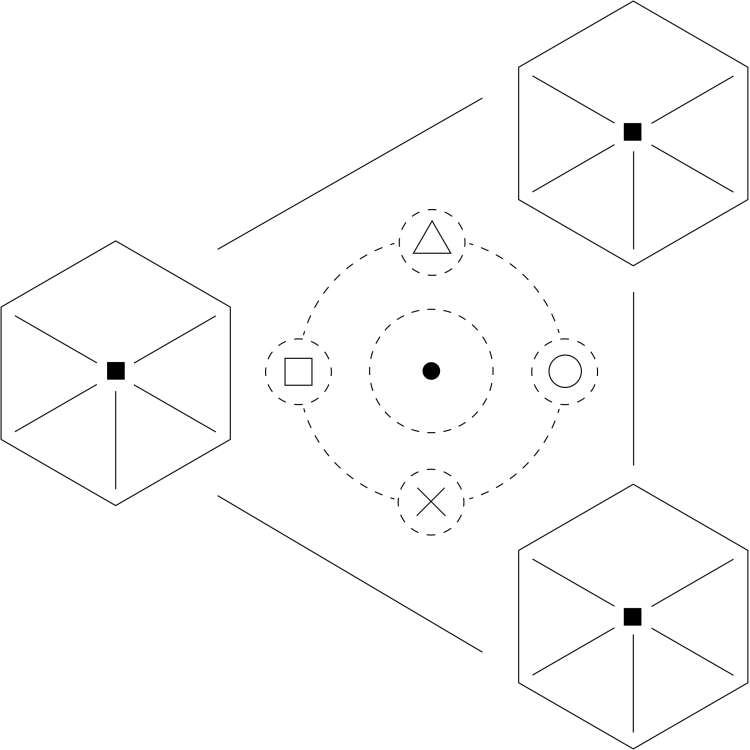Introduction
Overview
The web3 gaming space has seen a surge of interest over the past year, evidenced by the unprecedented number of investments funneling into web3 games and web3 gaming infrastructure. In our most recent VC report, we identified gaming as a massive driver for new early-stage crypto investments. Prominent funds such as Galaxy Interactive, Immutable, and a16z each raised $325mn, $600mn, $500mn, respectively, to invest in web3 gaming startups. Yet, mainstream gamers have been anywhere from lukewarm to outright hostile towards potential web3 integrations. When Fandomspot surveyed 2,000 gamers late last year, they found that 69% of those surveyed hate NFTs. While we believe web3 will play a massive role in the future of the video game industry, there is clearly a tension brewing between gamers and web3 builders.
In this report, we will examine 50 years of gaming history with a particular emphasis on past experiments in developing in-game economies. By studying what has been tried before in gaming, we can better predict how web3’s journey into the gaming space may play out over time. We also outline the main psychological motivations underpinning gamers and examine a couple notable experiments in web3 gaming. Our goal in this report is to paint a clear vision of how the future of web3 may (and may not) revolutionize the gaming industry. Many innovations espoused by web3 gaming startups have, in fact, been tried before, and it is our goal to separate fact from fiction as we analyze the potential for web3 to augment gaming applications.
Fast Facts:
The global gaming market reached $198.4bn in 2021, more than the film and music industries combined ($99.7bn and $26bn, respectively)
The rapidly growing gaming space is projected to reach $260bn by 2025
The average gamer plays 8 hours and 27 minutes per week
US gaming revenue is projected to hit ~$90bn in 2022
Mobile games make up about 50% of gaming revenue, with consoles making up ~30% and PCs making up the remaining ~20% of the market
Key Takeaways:
Tokens later, game first. Web3 is best suited to augment fun games, not masquerade as the star of the show. Web3 should be seen as a backend accounting feature that makes in-game digital assets more useful to players. It should not be seen as a panacea that will unilaterally improve games. Most gamers today are skeptical of web3 primitives and happy with the status quo. The gaming industry will not be challenged by web3 overnight. Rather, web3 game developers will need to convince a skeptical userbase of the benefits of crypto/NFTs with killer gaming applications.
Major game publishers are cautious about web3. Ubisoft has walked back on their initial bullish comments towards NFTs. Apple seems to be content to stick with its onerous 30% tax on in-app NFT purchases, despite this decision’s likelihood to limit web3 adoption on its platform. Web3 game development will likely occur at the fringes until mainstream adoption hits another inflection point. Similar to the reluctance of legacy game developers to embrace mobile phones, we predict smart web3 gaming operators to capitalize on the lack of competition from industry juggernauts.
Composability will be bottlenecked by Layer 1/blockchain ecosystem choice. For instance, a game that issues its currencies on its own Avalanche subnet would be far less interoperable than a game that deploys to Solana mainnet. Perhaps massive publishers will aggregate all their titles under a single layer 1 app chain built on top of protocols like Cosmos. The point is, there is a massive spectrum to the degree with which a game developer will make their in-game digital assets composable with other permissionless protocols. If a developer chooses to deploy on a siloed layer 1 with permissioned validators, many of the benefits of web3 will be minimized. It will be especially interesting to watch for web3 games that are built on protocols with very strong permissionless ecosystems unrelated to gaming such as DeFi, NFTs, DAOs, etc. Early data seems to suggest the opposite trend is happening, with game development congregating towards permissioned, siloed layer 1 blockchains like BNB Smart Chain and WAX.
Non-transferable NFTs will likely be a key primitive for web3 games. Many benefits of web3 can be obtained by non-transferable NFTs. Player achievements and unified logins through wallets can enable a player’s history to travel with them across various platforms and game environments. The permanence and open-source nature of permissionless blockchains ensures that developers can always build new experiences upon this treasure trove of on-chain history. This use-case alone is already a massive improvement over the status-quo, and we expect legacy game developers to experiment with this before introducing riskier economic primitives (such as fungible tokens).
Meta games will reign supreme. Meta games, or games built on top of other, existing games, are an obvious first move for aspiring web3 game developers. Platforms like The Sandbox are fully embracing this approach by encouraging developers to build within their ecosystem of NFT land plots and the SAND token. Successful developers benefit with existing infrastructure and intra-platform composability. The Sandbox benefits from diversifying its token economy across various games.
Bridges will be key to mainstream adoption. We are already seeing an environment where game developers are building games on top of dozens of competing, non-interoperable blockchain networks. In this multi-chain crypto gaming future, bridges will be necessary to support cross-chain interoperability. Although there is a possibility that game developers consolidate into one ecosystem with built-in interoperability features, such as Cosmos, this seems unlikely as the web3 gaming space currently stands.
More control, more money. Control over economies has historically been correlated with profits, and legacy publishers will be reluctant to give that up. One potential solution we see here is for publishers to employ a semi-open game economy that is siloed onto a single shard/subnet/app chain. In this scenario, the publisher would allow tokens/NFTs to work across any of their titles, but they would not allow money to leave their broader ecosystem. Regardless of whether this model is ultimately good for gamers, we would be surprised if developers don’t try it initially.
Tournaments are a compelling use-case for permissionless NFTs/fungible tokens today. Examples of this dynamic working in practice can be found across Sorare’s suite of NFT trading card fantasy sports games. The reason this model works is because the NFTs are not required to start playing, and they only become a factor as a player increases his/her skill with the game. We see this model working well in traditional game genres such as Call of Duty and League of Legends where tournament play is commonplace with high monetary and reputational stakes at play.
Not everything needs to be on-chain. Good web3 games will use a mix of off-chain and on-chain assets. On-chain transactions are costly from a transaction fee and data storage perspective. Today, most gamers are not spending any money at all in-game. The logical conclusion from this trend is that there must be a mix of both on-chain and off-chain assets to cater to all types of gamers. Casual gamers might be best served by assets that live completely off-chain, and this might be preferable for onboarding mainstream users who might not understand the benefits of crypto/web3 in the first place.
Game developers may rely on DeFi-inspired business models to monetize. Imagine two separate games built on the same blockchain supplying liquidity for the biggest swap pool for their respective tokens on Uniswap. In this scenario, gamers win with composability across different games and the developers win with income generated by LP fees. We imagine creative business models that stay true to the permissionless, composable ethos of web3 to emerge over time and challenge the microtransaction-driven business model dominant today.
What does Web3 do for Gaming?
On the surface, the gaming industry appears to be a natural fit for web3 products and protocols. Web3 developers can instantiate new economies with tools built on top of permissionless blockchains, such as fungible tokens and NFTs. Throughout history, popular games were built with a keen eye for how the in-game economic models affected gameplay and user engagement. In games like Pac-Man, a skilled player is incrementally rewarded with points as they progress successfully throughout the course. In games like Runescape, players can speculate on the price movements of tradeable in-game assets. In fact, many players receive a great deal of satisfaction from being right about price movements, and entire grey markets consequently emerge to transform in-game value into real-world value. Finally, games like League of Legends embody the economic principles of comparative advantage and specialization with tradeoffs between player roles such as damage dealers and tanks. Thus, the primary purpose of in-game economies is to serve as vehicles through which players exercise their free will to transform from their initial state to their desired state. Web3 primitives like NFTs and fungible tokens can operate as double-edged swords with both the potential to unlock new economic tools for video games and the potential to adversely impact game designs, detracting from player enjoyment. Thus, a rigorous understanding game economies is crucial to unearthing where web3 fits into the gaming landscape.
There has been significant hype in the web3 gaming space due to the number of innovations web3 primitives unlock for gaming applications from an economic standpoint. This hype is well-deserved, and it is important to underscore how web3 can benefit both gamers and creators from a utilitarian perspective. We categorize the main benefits web3 that unlocks for gaming use-cases into the follow taxonomy:
Liquidity: Gamers retain the optionality to buy/sell digital gaming assets. Whether they are cashing in before leaving an ecosystem or bootstrapping a suite of NFTs before starting a new game, gamers benefit from a global, permissionless liquidity layer enabled by DeFi applications.
Scarcity: While scarce items have existed in games for decades, these items are now built on permissionless blockchains in a trustless manner. Scarcity transcends an individual game's state into the global state enabled by public blockchain. Player can bring their scarce items with them to other applications.
Self-custody: Unlike a digital asset or in-game currency that can be taken away from someone at the whim of a central authority (example), NFTs are custodied by players in their own wallets. As long as the player controls their own private keys, they also control their NFTs and/or fungible tokens. (Note: this does not necessarily translate into IP ownership which is a complex issue we discuss in this report.)
On-chain Reputation: One of web3's biggest promises is creating an accountless internet model that unifies applications under the umbrella of a single sign-on through a user's web3 wallet. One consequence of this paradigm shift is that a player's reputation from one game can be read in by another game due to the openness and persistence of on-chain data.
Permanence: Once an NFT or fungible currency is instantiated, it exists on the blockchain forever. This is powerful in a world where gaming APIs and servers are routinely deprecated by even the most popular games. Long after a game server shuts down, other developers can step in to honor the utility of the digital assets and retain collectible value.
Auditability: An item's provenance is recorded in the blockchain. Some items may gain value simply because of who has held it in the past. Imagine owning a gun skin used by the winner of Fortnite's first World Cup. This mirrors the sports memorabilia industry with the added benefit of eliminating counterfeits completely.
Decentralized Governance: Highly-engaged players can drive the strategic direction of the games they play through DAOs, councils, and guilds (such as Illuvinati Council, Yield Guild). Users can even benefit from the economic value accrual for being early adopters of a game’s digital assets, with those values rising as a game's popularity increases.
Payments: Crypto can power seamless payments in-game with minimal friction and fast finality. Player-to-player payments and tipping are possible without central rent-seeking intermediaries. Creators on streaming platforms can monetize at a higher take-rate than what is possible through juggernauts like Twitch and YouTube. Prize pools and tournament payouts can be built natively without reliance on 3rd-party APIs like Plaid/Stripe.
Business Model Innovation: While free-to-play dominates gaming today, it also creates an environment that is less conducive to creativity in the gaming industry. Web3 enables brand-new economic models to be tested. Early adopters can share in the risk/reward profile for developing games with fungible tokens and NFT primary sales (though this carries its own set of challenges we discuss later). Customer acquisition costs may decrease and retention may increase when players have skin-in-the-game (though this is not necessarily the case depending on the economic design of the game).
Composability: Allowing completely different games to interact with one another will unlock new gaming use-cases that have never been possible before. To the extent the gaming space is built out on siloed blockchains, this vision will take longer to achieve and may require cross-chain bridging.
There have already been several experiments sitting at the intersection of gaming and web3 that we can learn from this past cycle. Two key insights immediately present when looking at this high-level data.
This space has endured its own set of growing pains, evidenced by the decrease in market cap for the top GameFi tokens by roughly 75%.
Web3 games have not yet consolidated around a single chain, with many chains seemingly vying for market share in the web3 gaming space.
Much of this decline in GameFi market cap can be attributed to the decline in crypto space broadly, and there lies the key problem with web3 games today. Today, web3 games behave more like DeFi protocols with a thin-layer of game-like utility sitting on top. Good web3 games should be fun to play in the absence of any web3 functionality, first and foremost, and they should be able to endure, and even prosper, in bear markets. While global consumer spending on the gaming industry might decrease in a down market, engagement with popular titles often stays relatively consistent. This is perhaps best evidenced by the record-breaking sales numbers Activision enjoyed with its Call of Duty series during the depths of the Great Recession.


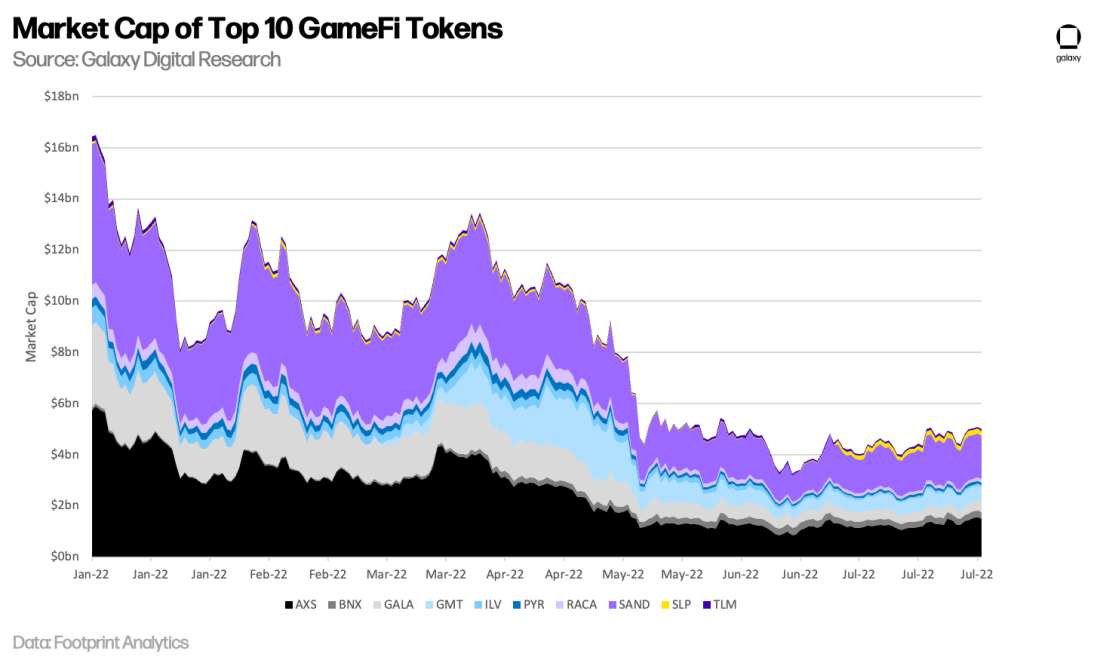
Most importantly, web3 games aren’t built in a vacuum. The gaming industry has been around since the 1970s, and there is a wealth of knowledge from these years of trial and error that can be leveraged to create better blockchain games. In the next section, we will unpack the history of gaming with an emphasis on experimentations in game economy design.
The History of Economies in Video Games
1978-1983: The Golden Age
The video game industry has come a long way since its humble beginnings in the 1970s. Atari is credited with releasing the first game, Pong, and the first video game console, the Atari 2600. What ensued is colloquially referred to as the golden area of video games. Atari was king during this era, and arcades were the dominant medium through which players played games. "Pac-Man" became a worldwide sensation. In fact, many newspapers and magazines would publish the local "Pac-Man" high score list, inciting competition and signaling status and hierarchy amongst players in the local gaming community. Players often gave each other tips and tricks to better their scores, which naturally led to communities forming around specific games.
The business model of gaming during this era was simple: a player inserted quarters into arcade machines and played the game until they ran out of lives. If a gamer spent more time at the machine, the arcade made more money. Thus, the act of playing an arcade game in and of itself was the primary economic activity. Games were engineered to be easy-to-learn and difficult to master in order to optimize the time spent at the machine and the lifetime value of an arcade gamer. This battle-tested approach remains a hallmark of game design today. Video game arcades in the United States ultimately reached their revenue-earning zenith in 1981, with approximately 10,000 arcades generating close to $5 billion in revenue. This huge sum, which equals to more than $16bn billion in today's dollars, is especially impressive considering the physical limitations of clustering large arcade cabinets in small spaces and the friction associated with using physical coins.
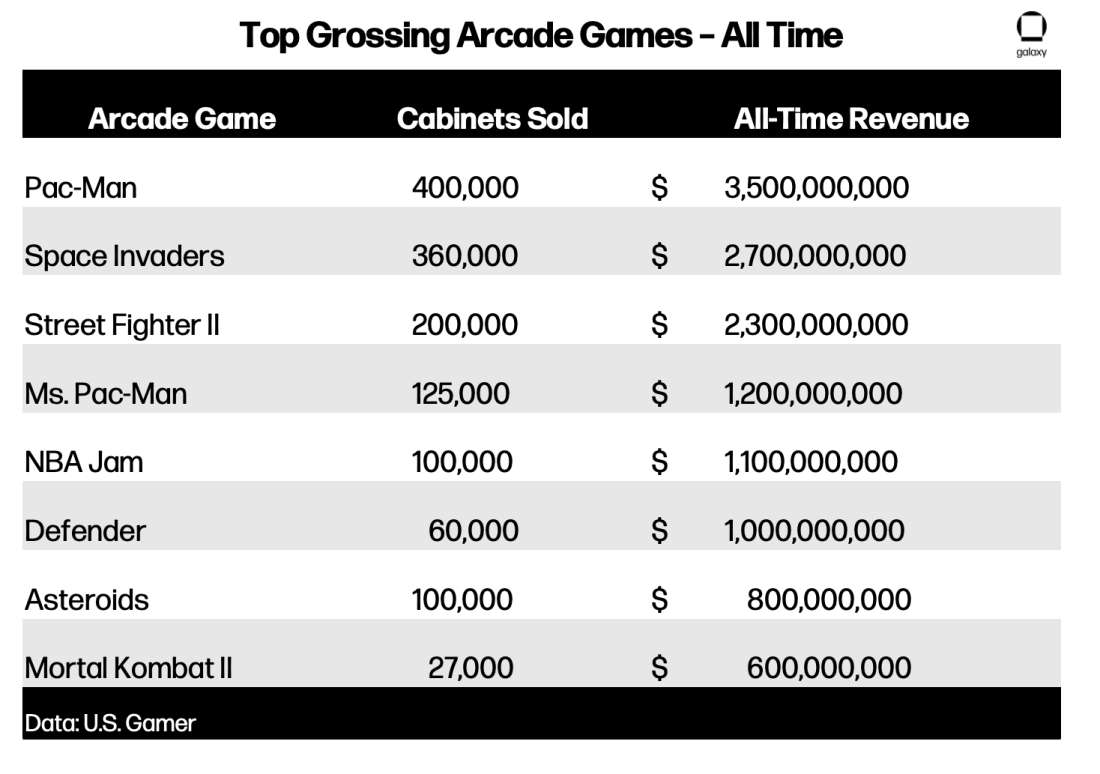
1983: The Video Game Crash
By the early 1980s, licensing difficulties, an overabundance of developers, and widespread consumer dissatisfaction in both the quality and substance of video games started to devastate the industry. In 1983, profits had plummeted by 30-40% across the board and nearly 2,000 arcades had shut their doors. New technologies, such as disc-based software, were still cost-prohibitive for many consumers. The golden age of arcade gaming was officially over, and the period between 1983-1985 was known as the Video Game Crash. This era is important to note as it draws many parallels to the boom-and-bust nature of cyclical crypto markets.
Atari was one of the businesses most negatively impacted by the video gaming crash. By mid-1983, Atari had lost $356 million, and it was forced to lay off 30% of its 10,000 person workforce. Unsold Pac-Man, E.T. the Extra-Terrestrial, and other 1982 and 1983 games and consoles began to fill their warehouses. In September 1983, Atari infamously disposed of 700k unsold cartridges in a landfill near Alamogordo, New Mexico. Atari's cartridge burial remains an iconic representation of the depths of the 1983 video game crash.

This story arc of the early gaming industry parallels the crypto space in some ways. From the oversaturation of NFTs, to licensing issues (which we discuss here), to the subsequent decline in NFT trading volume, and, finally, the crypto asset cycles themselves. Those who were long-term bearish on video games in the mid-1980s ended up looking foolish today. Similarly, those who are long-term bearish about crypto today will almost certainly foolish in a decade. The question is, what will the journey towards mainstream web3 gaming adoption look like? The next couple of eras in video gaming history offer some clues of what’s to come.
1985-2013: The Console Wars
The years between 1985 to 2013 are known as the "Console Wars," defined by the rise of in-home consumer hardware to power gaming experiences. The console wars represented a complete shift in business practices for the industry, and it was during this era that sophisticated experiments with in-game economies were first tested. During the console wars, industry revenues also exploded, challenging those of Hollywood. The staggering output of 100 million PlayStation consoles, and later over 150 million Playstation 2 consoles worldwide symbolized the massive reach of video game consoles in households. Ultimately, the console wars amount to an era of time when Nintendo, Sega, Sony, and Microsoft released competing consoles on similar schedules 7 times.
The introduction of the Nintendo Entertainment System (NES) was one of the most significant events in video game history and it marked the official beginning of the console wars. Nintendo's objective with the NES was to breathe new life into an industry still recovering from a devastating crash, and they took great care in designing and marketing the device to accomplish this goal. Nintendo designed the NES to be as user-friendly as possible. The NES game cartridges were called “Paks” instead of game cartridges, and the system was dubbed the “Control Deck.” In order to give the console a more Americanized, VCR-like appearance, they changed the console name from Famicon (the console's Japanese market name) to NES and replaced the red and cream colored Famicom shell with the now famous grey box design. This helped the console look less like a frivolous toy and more like a serious machine nestled inconspicuously inside one’s entertainment center.

Where prior game companies sought to push as many titles as possible to chase short-term gains, Nintendo preferred stringent quality control and long-term consistency in titles. Nintendo had infamously strict licensing standards, and limited third-party licenses to just five titles each year. Games such as "Super Mario Bros" and "The Legend of Zelda" were popular among players because they included in-game economies that allowed players to spend in-game virtual currency on items and upgrades. While these games weren’t the first to introduce digital assets, they were instrumental in bringing in-game economic design to mainstream audiences. Depending on how well a player performed, they could earn coins and items that would directly impact their gaming experience. The NES ended up being so successful due, in part, to its in-game economic features that other consoles at the time like the Sega Genesis would go on to copy this idea. While Nintendo can be credited for kick-starting the console wars and popularizing digital assets in games, their contributions to the gaming industry extend far beyond hardware and software. Much like the NFT space in web3, Nintendo was also laser-focused on creating a unique culture centered on their intellectual property.
Nintendo's culture of exclusivity was anchored by superfans of their games. For instance, Nintendo Power magazine, which effectively served as marketing material for Nintendo products, captivated audiences with colorful imagery and the illusion of receiving exclusive insider knowledge. It was often filled with lore that teased at future game releases and promoted popular games. Nintendo also invested millions of dollars to organize fan clubs across the nation and train on-demand game counselors to offer advice to players on the phone. In some ways, Nintendo's fan clubs were a precursor to the moderated Discord servers of marquee NFT collections today.
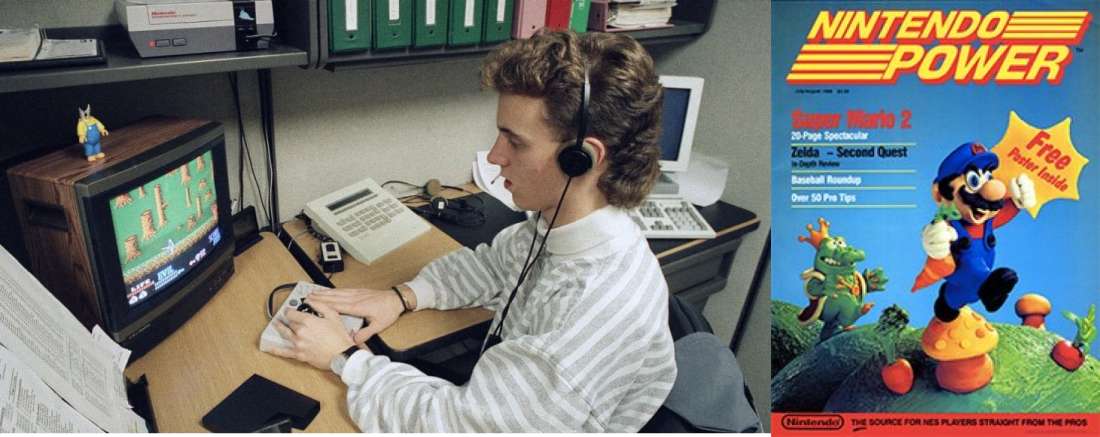
Yuga Labs is reminiscent of Nintendo in the 1980s. At Nintendo's peak in the late 1980s, Nintendo products accounted for nearly 80 percent of the home video game console market and 20 percent of the toy market. Yuga Labs shares similar levels of dominance with 58% of NFT market cap on Ethereum and 20% of all NFT volume (according to data from Dune and Coingecko, see below charts). Clearly, it wasn't just Nintendo's superior product suite that led to their initial dominance. Rather, it was their branding and marketing prowess coupled with their killer 1st-party games that powered their rise to the top. Yuga Labs' token-gated events (Ape Fest) and Discord channels can be seen as modern-day manifestations of Nintendo's early practices. NFTs, such as Yuga Labs' Bored Ape Yacht Club, seem well-positioned to serve as infrastructural glue that bond players together much like Mario did for Nintendo in the early days.
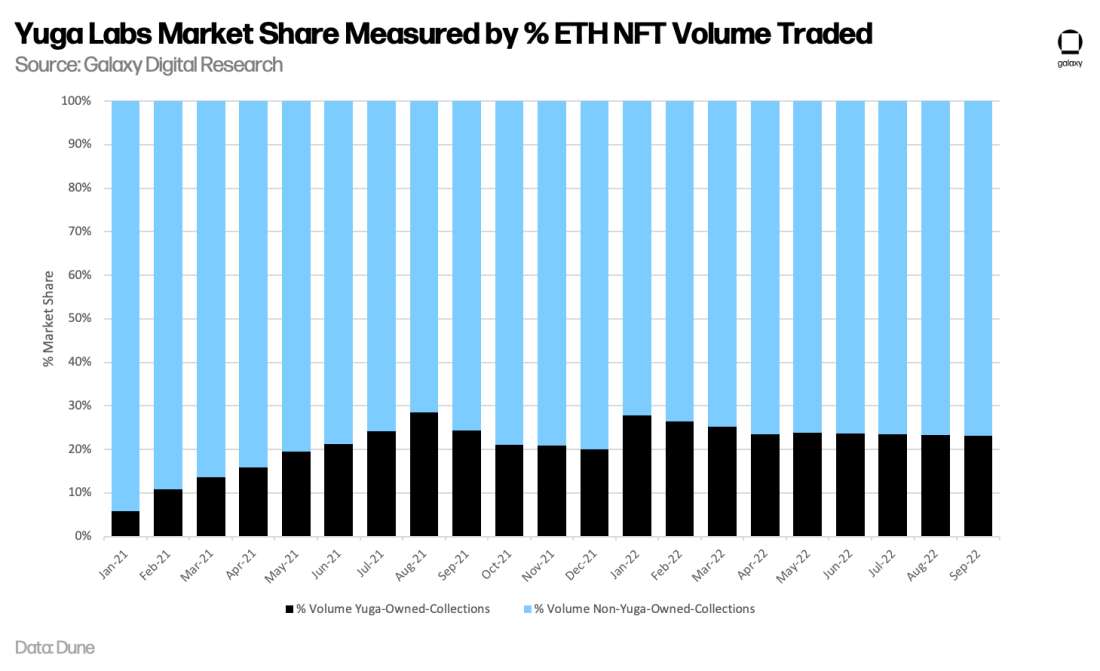
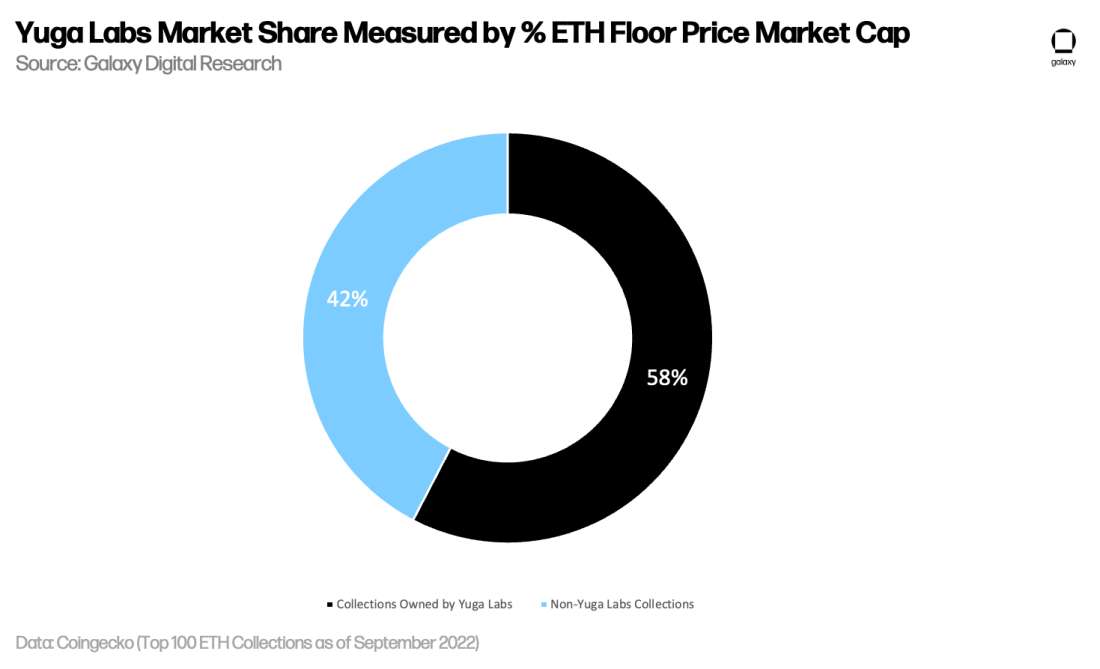
Early 2000s: The Advent of Online Gaming
As the battle of the consoles raged on throughout the 1990s and 2000s, online gaming was lurking in the shadows and poised to change the industry forever. With the internet, game economies were no longer sandboxed to individual player states. Instead, the internet could maintain a single shared state across many instances of individual player sessions. One obvious benefit of unifying connected players across a single online state was the ability to introduce player-to-player interactions. Global leaderboards took the mantle from local arcade high-scores and brought player hierarchy back to the forefront of gamers’ minds. Most importantly, online gaming completely changed the unit economics and distribution of video games. This what allowed novel economic designs to thrive and serves as the foundation upon which many web3 games are built on today.
Ultima Online, a massively multiplayer online role-playing game (“MMORPG”) released in 1997, was the first video game to have a player-driven economy. In these types of games, players can trade goods and services with each other instead of being limited to set items within the game itself. Ultima Online's success led many others to follow suit, such as EverQuest, Runescape, World of Warcraft, and Second Life. Soon after, private markets in video games naturally blossomed, and these in-game economies were often filled with inefficiencies and arbitrage opportunities. In fact, there were entire classes of players in games like Runescape who made massive fortunes of in-game wealth purely by exploiting these market inefficiencies. Thus, it was no longer the case that one had to be a skilled player in to acquire massive amounts of resources. A player could signal massive amounts of in-game status and wealth by simply being a skilled trader. This is also what birthed Real-World Trading (RWT) grey markets which allowed for the exchange of in-game items for real-world currencies. The play-to-earn craze of 2021 has many parallels with the dynamics of RWT in MMORPGs down to the core demographics who served as laborers and profiteers (often Eastern, low-wage laborers servicing Western players).
In 1999, EverQuest launched as a PC game and proved that not only was massive multiplayer online gameplay possible, but also that a subscription-based business model could work. Blizzard built on EverQuest's subscription model when it launched World of Warcraft in 2004. The game grew rapidly in popularity and, by 2008, amassed over 10 million paying subscribers. As it became the most popular and successful massively multiplayer online (MMO) game in history, World of Warcraft proved the viability of ongoing revenue streams for gaming. World of Warcraft and other MMOs also pushed the industry toward genuine globalization. Both factors, ongoing revenue streams and globalized audiences, are now being replicated as key primitives of web3 gaming by virtue of NFT royalties and decentralized player-bases.
Valve's Steam platform in 2003 was the first experiment in online-only game distribution. Through Steam, players could buy, download, play, and update games directly from the one platform. Through this medium, incomplete games could be sold with the promise of future downloadable content (DLC), add-ons, and expansions. Crowdfunded games leveraged the lower barriers to publishing through online distribution and started raising money for partially developed games. This shift represented a change in the relationship between consumer and game developer. In the console war era, game developers were insulated from and obfuscated by publishers who boxed and distributed physical games and managed marketing budgets. Indie developers who struggled to catch the attention of publishers could now market game concepts directly to consumers with the hope of raising funding in a decentralized manner.
The rise of online distribution and crowdfunding in the 2000s certainly draws similarities to the current model of web3 game studios raising funds from a combination of fungible and nonfungible token sales. The issue with this distribution strategy, which we've seen in early experiments in crowdfunded games, is that the initial market feedback directed at half-finished products can be deleterious and outright harmful to the development of the game itself. The fact that there are secondary markets around pre-product web3 games exacerbates these dynamics, and it is unclear if this model will endure in the long run. Liquidity may not always be good when projects are in their early stages as price crashes can demotivate both the team and its early-adopter community to the extent they have downside exposure.
2010s: The Rise of Mobile
While Steam was a pioneer in online game distribution, Apple's App Store in 2008 was the watershed event that signaled the arrival of a new rival to the gaming industry. Major gaming companies, such as Nintendo, Sony, and Microsoft, and other top game developers were initially dismissive of the App Store. This miscalculation allowed smaller independent companies to compete on this new frontier of mobile gaming. In contrast to console titles, which rose in price to hundreds of dollars for a console with an additional $50-$100 per game, the App Store provided games that could be downloaded for a low price or for free. Developers were keen to leverage the low entry point and ubiquitous distribution vehicle (smartphones) to reach a much larger addressable market. Today, mobile gaming has eclipsed console gaming by a factor of two, effectively killing the entire portable gaming console market in the process.
In the same year the App Store was born, the console video game industry hit its peak. The bulk of revenue generated from the sale of games came from games designed specifically for high-end hardware. While these same games were frequently offered on "PC" or personal computers, their console variants accounted for far more revenue. At the same time, the distribution of revenue stemming from console games was incredibly power law distributed. As much as 80-90 percent of games made during this period were economic failures and failed to make back the money invested in their development. The gaming industry is extremely hit-driven. Seen from this historical lens, it's not hard to understand why perhaps 90% of GameFi NFTs and tokens will also potentially fail. There is a lot of historical precedent for these challenging market dynamics, and such is the nature of a finicky, consumer-demand driven industry.
This hit-driven nature of the gaming industry has also drawn comparisons to the major box-office film business. In Hollywood, many films are financial failures that are made up for by massive returns from "summer blockbusters". The proceeds from these homeruns are then used to finance the production of other movies, and the cycle continues. The lower upfront development costs and simplicity of mobile games were appealing to developers who wanted to challenge the economic viability of blockbuster-driven development. Crypto and web3 are having their mobile moment today where small development teams can finance their entire runway with an NFT drop in hopes of producing a popular game for release a few years later.
Present Day: Free-to-Play
The meteoric rise of free-to-play was driven by an amalgamation of a global economic recession, the rise of cheap mobile games, and the popularity of online multiplayer. Game console manufacturers had to stretch the lifespan of their mid-2000s consoles from 4 years to 7 years (8 in the case of Xbox). Consumers were less eager to shell out $60 for a console-based game, especially considering that the average campaign mode only lasted a dozen hours. This drove a consumer shift in taste towards the abundant replay value of online multiplayer gaming. This era of economic contraction also led birthed an industry-wide obsession with in-game economic design that was tethered heavily to consumer psychology.
How do game developers make money from free games? The answer is simple: microtransactions. Free-to-play games are synonymous with microtransaction-driven revenue models. While mobile games were the first to demonstrate the viability of microtransactions, game developers soon realized that free-to-play game economics were key to unlocking vast amounts of ongoing revenue. By removing the upfront cost, all friction to try out a game was gone. Game developers could cast a wider net in the hopes of catching a whale (consumers with disproportionately high lifetime values). Multiplayer-focused games, like Fortnite and Warzone, leverage microtransactions to give players the ability to earn cosmetic items for signaling status in-game. Mobile games, like Candy Crush, leveraged microtransactions to give players the opportunity to save time from key moments in-game.
By most measures, the free-to-play business model centered on microtransactions has been successful in generating more revenue for game developers. Below we list the top earning videogames of 2021 with the vast majority employing a free-to-play, microtransaction-centered business model.
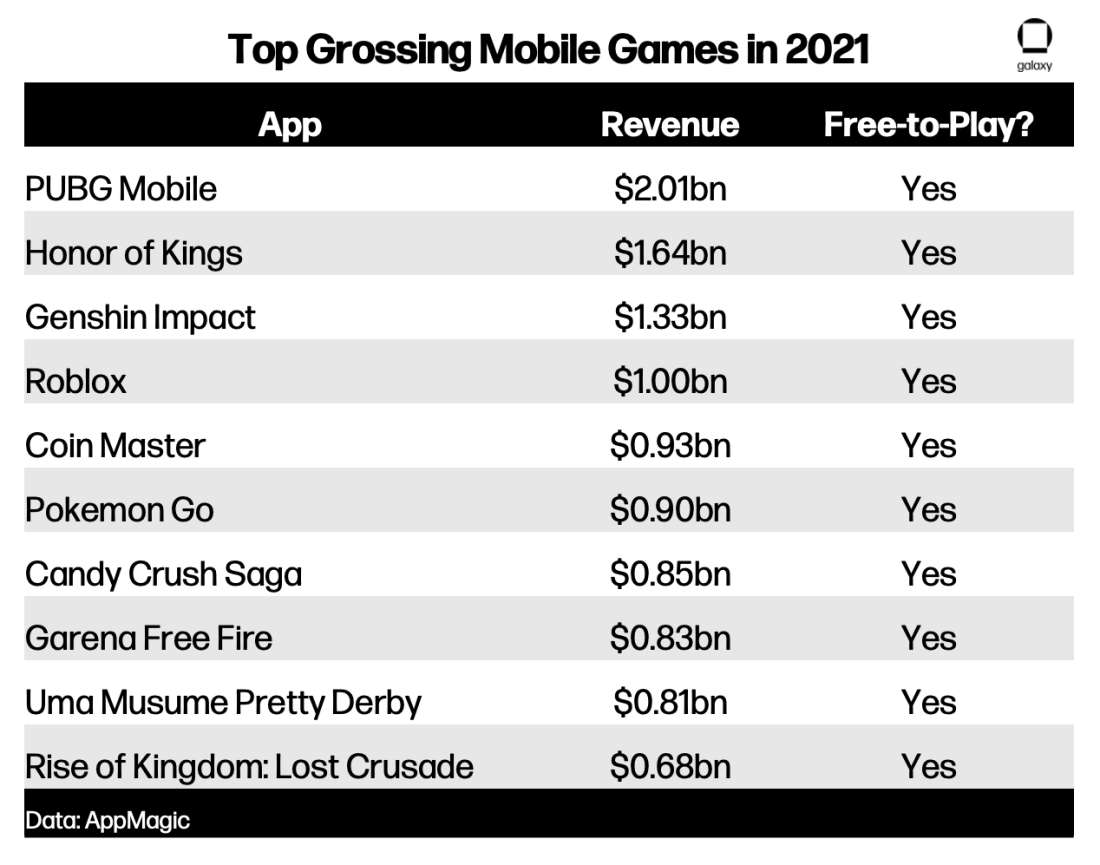
The gaming industry has swung like a pendulum from one economic model to another. In the early days of gaming, player engagement was directly tied to the revenue an arcade unit generated. The arcades themselves were operating on a microtransaction business model where entrance to the arcade was free and use of various games costed a single quarter. Industry revenue was at a local maximum as games were able to generate consistent, ongoing revenue over time. The birth of the gaming console shifted the economics of game development away from smaller revenue streams towards larger upfront purchases. This era, referred to as the console wars, dominated throughout the 1990s and 2000s and led to an industry-wide consolidation. Massive game studios and publishers vied to be amongst the select worthy of a consumer’s $60 spend on a single game. The birth of the internet and rise of mobile has shifted the business model of gaming back towards small, ongoing transactions. Game developers deliberately engineer their in-game economies to facilitate player spending throughout their entire lifetime as a customer. This microtransaction dominant era we find ourselves in today employs very complex economic systems motivated by psychology to maximize value extraction from various player-bases. In the following section, we examine the most common economic design primitives and psychological strategies that game developers leverage in games to maximize revenue generated. By understanding how game developers make money from players today, we can better understand where web3 has the potential to either augment or supplant the industry status quo.
Why do we game? The psychology of gaming
Video games differ from other media forms in that users are heavily engaged with and immersed in the game’s interactive environment. While it may be easy for a commuter to passively listen to a podcast while driving to work, that same person would have a much harder time juggling a video game in one hand and a steering wheel in another. Even in an age of information abundance accelerated by passive social media content streams, the revenues from the gaming industry continue to grow to record-breaking levels. Why is this the case?
In this section, we outline some of the psychological motivations for playing games as well as mechanisms employed by game developers to maximize user engagement. By studying psychology, game developers are better equipped to design environments conducive to the myriad player-to-player interactions that generate in-game economic activity.
Why We Play
There are many reasons people play games, and each individual player is likely to be motivated by some mixture of reasons. We highlight 3 key motivational buckets below:
Test skills: Games provide sandboxed environments where players can develop and test their own skills with live feedback against other players and/or a computer. Broadly, these skills encompass problem solving, navigating through a map/course successfully, player-vs-player combat, reaction times, critical thinking, and many other modalities. Pac-Man is a concrete example of this concept with audible and visual cues when a player successfully gobbles up dots, and clear negative feedback when a player is captured by a ghost. Players obtain a great deal of satisfaction from encountering new challenges and overcoming those challenges with feedback throughout the process. Well-architected games, with mechanisms such as skill-based matchmaking, smooth learning curves, and logical progression, will ensure that players stay in a flow state while playing the game. These flow states allow players to detach from reality and focus intensely on the task at-hand at the edge of their abilities, and this is a deeply satisfying psychological phenomenon.
Act independently: Gamers generally like to exercise agency over their actions and dislike when they don’t feel in control. Gamers want to feel responsible for their actions, regardless of the outcome. Too many artificial constraints can suffocate a gamer’s enjoyment of their environment. Good game developers can create environments that allow players to exercise full autonomy and control over their playable characters without introducing too much openness such that the game does not lack a purpose. This final point is a main area of distinction between game-like metaverse worlds, such as Second Life, which lack any directed gameplay, and popular games with metaverse-like features, such as Fortnite.
Connect with others: Games often serve as digital commons where players can interact with their friends or complete strangers. In first-person shooters, this may manifest in the form of pre-game chat lobbies and in-game team chat. In role-playing games, this may manifest as text or audio-based chat based on an avatar’s proximity to other avatars. In single-player games, this manifests in the form of good storytelling where the player is connecting with fictional characters. Humans are innately social creatures, and games provide a vehicle through which players can connect with one another and share experiences.
Types of Players
Richard Bartle was an early pioneer in documenting various player motivations within Role-Playing Games, and he published his initial four player archetypes in 1996. Given the importance of RPG games to the maturation of in-game economic design, studying these archetypes is crucial to understand how consumers will respond to web3 games. These four archetypes often hold true even outside of the RPG genre:
Achievers: Players who prioritize resource accumulation, status, and completion of all game objectives. These are the types of players who may complete weekly challenges in games like Fortnite and Warzone or aim to collect all in-game items in games like The Legend of Zelda.
Explorers: Players who deeply immerse themselves in the game’s environment, seeking to uncover new experiences and test the game’s technical limits. These are the type of players who seek out easter eggs and glitches, sometimes posting videos of these easter eggs to an audience on Twitch or YouTube.
Socializers: The lions-share of gamers. These are casual players who prioritize connecting with other players via in-game audio and/or text chat. They are typically less interested in following the game’s purpose and find satisfaction primarily from the feeling of belonging. Socializers also tend to cluster around friends who may fall into other buckets, and they help anchor strong network effects within games.
Killers: Players who gain satisfaction from impacting the experience of other players, typically to the other player’s downfall. They thrive on chaos and high-stakes risk-taking. In RPGs, these were the players who sought out other players in player-vs-player environments to steal their loot. In competitive games like Warzone or League of Legends, these are the ranked tournament players.
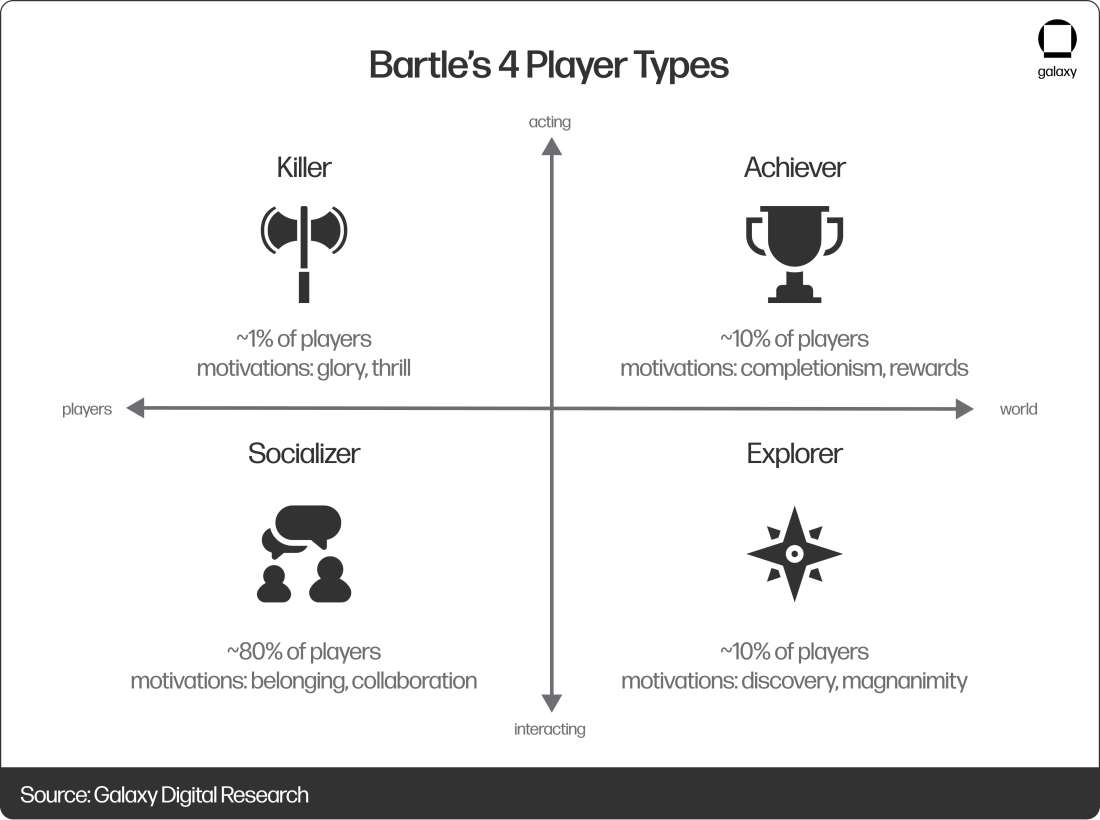
Game developers are keen to build games that factor in the demographic breakdown of their players based on these four buckets. Killers, for instance, tend to be the least common archetype and the least profitable segment. They tend to be singularly focused on one objective and are not the most accommodating or community-centric player base. In fact, an overabundance of Killers can prevent new players from entering the fray and severely impact the economic viability of the game. Fortnite had this problem as players got so skilled at ‘build battling,’ they prevented new players from enjoying the game. Fortnite’s response was to ultimately introduce bots that balanced out the dynamics and were easy targets for new players to feel accomplished as they got familiar with the game and explored Fortnite’s massive map.
On the other hand, Explorers tend to be among the more valuable members of a game’s community. Not only do they fervently create user-generated content for other players to enjoy (such as Fortnite’s open world creator mode), but they also create content for non-players to immerse themselves in the world via channels like Twitch, TikTok and YouTube. While Minecraft was perhaps the first game to build the entire experience around Explorers, games like Fortnite built on this feature set after seeing the ancillary benefits this player base can bring. Web3 games like The Sandbox are architecting their entire business model around this player archetype.
Achievers are usually more likely to be willing to pay for enhancements that gives them a better chance of advancing their leaderboard position. They are the players on games like Fortnite who are obsessed with collecting all the skins. This highly monetizable archetype is the easiest to nudge towards monetization. They will pay to achieve their goals faster.
Socializers are the most common segment, and most casual gamers fall into this bucket. Socializers play games to unwind and connect with their friends. They don’t typically have a strong loyalty towards a game outside of a game’s network effects. While they are easy to onboard with a free download, they are difficult to monetize. However, games that create strong feature sets for socializers will increase their TAM and boost their odds of capturing a whale. Though socializers are less likely to have the highest LTV among the four segments, they are likely to value digital assets such as cosmetic upgrades that allow them to differentiate themselves in the community and signal status within their friend circle.
Lessons in Gaming Psychology: Web3's Missing Ingredient
Game development today optimizes for a trilemma spanning challenge, gratification, and economic engagement. Like the infamous blockchain scalability trilemma, which we describe in our Ready Layer One report, it is very difficult to achieve proper balance without compromising on one of these 3 elements. Many consumers today lament the seeming over-emphasis on economic engagement, for instance, as evidenced by the never-ending firehose of microtransactions. One simple experiment to demonstrate this point is to examine the evolution of Call of Duty. Modern Warfare 2’s online multiplayer menu from 2009 looks barren compared to Call of Duty Vanguard (2021) cacophony of widgets, notifications, and prompts to nudge the player into spending money.
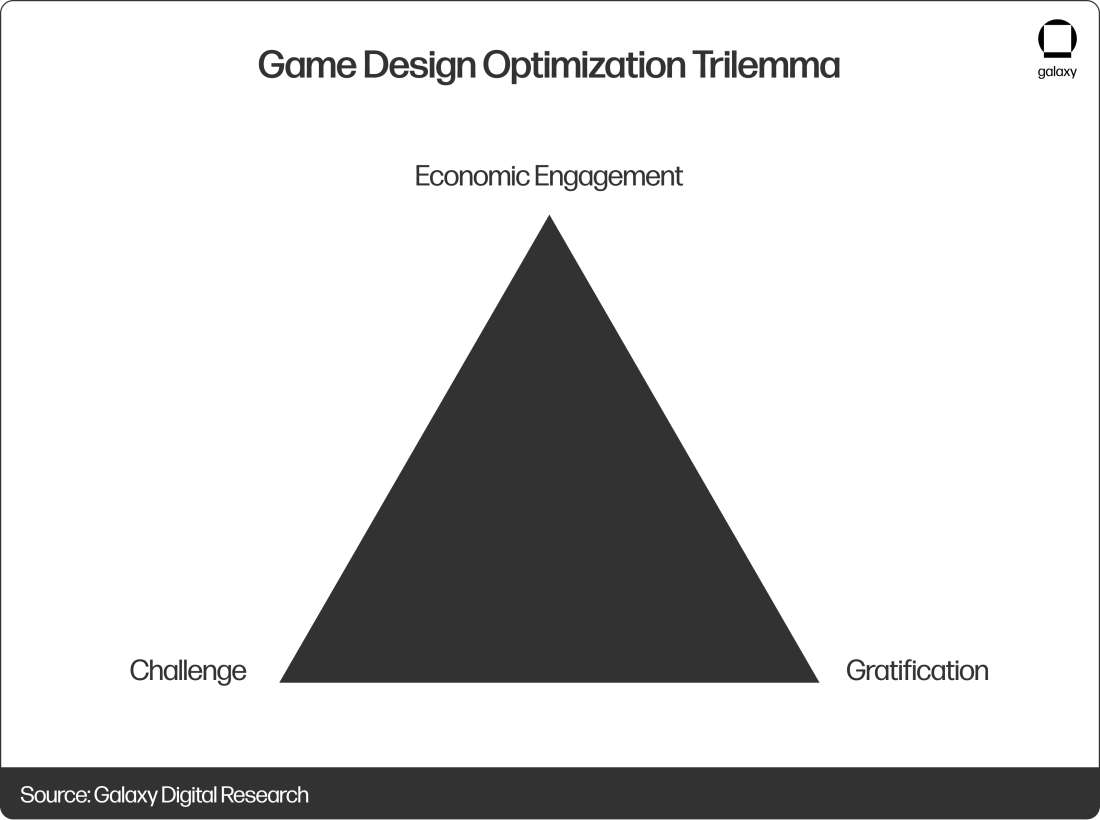

Freemium games, popularized by the mobile gaming sector, typically rely on a small percentage of players for the lion’s share of their revenue (referred to as whales). In 2014, Swerve found that 0.15% of players accounted for 50% of monthly revenue from in-game purchases. A 2016 study found that 10% of mobile users accounted for 90% of in-app purchases. As a result, game developers have an economic motive to focus development efforts on driving these monetization metrics up as even small increases in the number of in-app purchasers could drive massive increases in revenue.
Web3 game developers would be remiss to ignore the psychological levers used by most revenue-generating games today. Even if a web3 game developer hopes to subvert or improve upon these levers, a lack of appreciation for these important dynamics may yield suboptimal web3 utility that destroys the enjoyment of the game in the process (see Axie Infinity). Just because an in-game asset can be turned into an NFT or fungible token, doesn’t mean it should be made into one. In this section, we outline the main areas of innovation in game economic design that today’s web3 games often ignore to their detriment.
Sinks and Faucets
Sinks and faucets are mechanisms that game designers use to regulate the distribution of digital assets. In other words, "faucets" dispense digital assets while "sinks" remove them from circulation. Sinks and faucets are an extremely important game design primitive to understand because asset supply imbalances can render a game completely unplayable over time.
In designing sinks and faucets, game designers must think about both the growth of their new player base as well as the continued maturation of their existing player base. Designers want a successful game to be popular, which means new players are entering the community and utilizing digital asset faucets. This huge supply of fresh assets needs to be absorbed by sinks for current players so they may retain value associated with their present resources. This tension between new players entering the ecosystem without detracting from existing players' enjoyment of the game, by devaluing the digital assets they worked so hard to accumulate, is at the heart of sink and faucet design.
Given how important tokenomics for GameFi tokens and NFTs are to the long-term vitality of a web3 game's ecosystem, it is especially critical to think about sinks and faucets from a web3 perspective. If players don't have an in-game activity to spend their tokens on, the supply of those tokens will create enough inflationary pressure to sink the price of the game's token. This might lead to a death spiral in the game's ecosystem as players abandon ship for greener GameFi pastures. This is what we essentially saw play out with both Axie Infinity and STEPN.
Below, we outline the most common sink and faucet mechanisms across both traditional games and web3 games. Understanding these mechanisms is crucial to potentially identifying strong (or weak) web3 game economic design.
Utilities: Typically, these are nominal costs for ongoing in-game activity such as Runescape’s toll at the Al Kharid gate or the armor depreciation mechanics in games like Elder Scrolls. Game developers need to be careful to not rely too heavily on utility sinks as they can make the game more painful than enjoyable for players.
Casinos: The introduction of gambling mechanics in games reached its zenith in the mid to late 2010s. On the one hand, they serve as extremely effective sinks with statistically guaranteed negative expected value for players. Developers usually dangle the rarest in-game items as rewards, stimulating strong demand from the player-side for these rare items. Examples include Loot Boxes in Call of Duty (since discontinued in favor of Battle Passes) and Runescape’s Treasure Hunter. The issue with introducing in-game casinos is that players hate them and view these as exploitative measures. Regulators have also been increasingly hostile towards this mechanism with countries like Belgium outright banning the practice in 2018.
Collectibles: One of the simplest and most effective sinks is selling ultra-rare collectibles, for high amounts of in-game currencies, directly to the players. Examples include condensed gold in Runescape, which costs upwards of 10mn GP and can’t otherwise be made by players. These types of sinks tend to be the well-received by players as they don’t inherently change the game’s mechanics and they reward long-time players who have accumulated enough resources to buy the collectibles in the first place. It also allows these same high-tier players to signal social status and hierarchical worth by way of displaying these expensive, collectible items. In the world of web3, grail NFTs issued directly by a game would achieve similar goals, and this mechanic seems like an inevitability for future web3 game developers.
Taxation: In-game taxation serves as a sink to counterbalance new digital asset issuance. Traditionally, taxes in games are levied by game marketplaces, such as RuneScape’s Grand Exchange, which not only charge a 2% tax on each sale but then uses the proceeds from these sales to buy back and burn additional items listed on the marketplace. Taxes are already leveraged in the web3 gaming space with Axie implementing a 4.25% tax on all marketplace sales and Star Atlas outlining a plan to implement a land value tax. We expect in-game taxation to be commonplace across web3 games.
Consumables: Consumables are high-velocity, low-value, in-game items that are used by players to create high-value, non-transferable items. RPG games, like Runescape’s construction skill, are the canonical example of this sink mechanic. Essentially, players have a strong incentive to signal status with player-built houses, and, most importantly, these houses cannot be bought or sold. They must be built by the players themselves with the player’s construction skill. The act of levelling up one’s construction skill in Runescape requires the player to churn through massive quantities of raw materials like planks, nails, and tools. However, the satisfaction of levelling up this skill coupled with the creative outlets it provides to players, and the social clout it grants players, actually makes it a compelling use of one’s resources. As a result, demand for these consumables manifest in a very organic manner, helping eliminate massive quantities of the game’s currency from circulation. In the Runescape example, planks are the number one item transacted on the platform’s Grand Exchange. We imagine successful web3 games, particularly those incorporating virtual land, to employ a similar mechanic using a mixture of transferable and non-transferable NFTs.
Donations: Perhaps the most community-friendly of all sinks, donations are in-game mechanisms where players literally burn their in-game currency. Runescape famously implemented this with the Well of Goodwill and awarded players rare titles/accolades based on the amount donated. The rarest title in the game, “The Billionaire” was awarded to those players who donated 5bn GP or more (an extraordinary amount even for elite players). The social clout that came with this non-transferable title dwarfed that of party hat holders (the rarest in-game item). This mechanism is also reminiscent of in-game prestiging popularized by Call of Duty 4 (and discussed in detail in a later section).
Staking: Although staking mechanisms have existed in games before web3, they were popularized by DeFi protocols and are a core primitive in the web3 gaming space. The purpose of staking boils down to removing currency and/or NFTs from marketplaces by incentivizing users to stake their digital assets in exchange for earnings. Axie Infinity incorporates staking mechanisms for both its fungible currency and non-fungible land plots. Yuga Labs also plans to incorporate staking of their $APE coin, the native fungible currency for their Otherside metaverse game. The key challenge with staking, as seen with the rise and fall of OHM forks last year, is preventing new currency issuance used to pay yield to stakers from devaluing the currency itself. If a gaming protocol simply relies on massive token inflation to incentivize staking pools, the sink turns into a faucet.
Fees from Ancillary Infrastructure: STEPN is the canonical example of a web3 game levying this model. To swap SOL tokens for GST tokens, the user is forced to swap via STEPN’s integrated exchange. STEPN takes a fee on each swap and could theoretically also use the earned funds to burn excess tokens. By creating a core piece of infrastructure to power the game, developers can charge fees in the game’s native currency and create a natural sink.
Derivative Works (mods): Games like Fortnite and Minecraft encourage community-driven game mods that build on top of the base game’s underlying architecture. Web3 seems extremely well-positioned to fully leverage the power of community mods for games due to the open-source ideology commonplace in web3 developer circles. So long as the modded version of the game requires the same in-game currencies and/or NFTs as the base game, the modded games will naturally spawn increased demand for in-game currencies. This organic demand can theoretically counterbalance new digital asset issuance. The Sandbox metaverse platform is architected with this strategy front-of-mind. Broadly speaking, “meta games,” or games built on existing infrastructure and/or IP, are well-suited for web3 games to leverage as currency sinks.
Garbage Collection: This sink mechanism simply refers to the phenomenon of a player dropping an item (typically in an RPG game) and the game itself completely deleting the item from existence once enough time has elapsed and no other player has picked the item up. Most players are savvy enough to prevent valuable items from dropping and disappearing, so this sink has limited effectiveness compared to other methods.
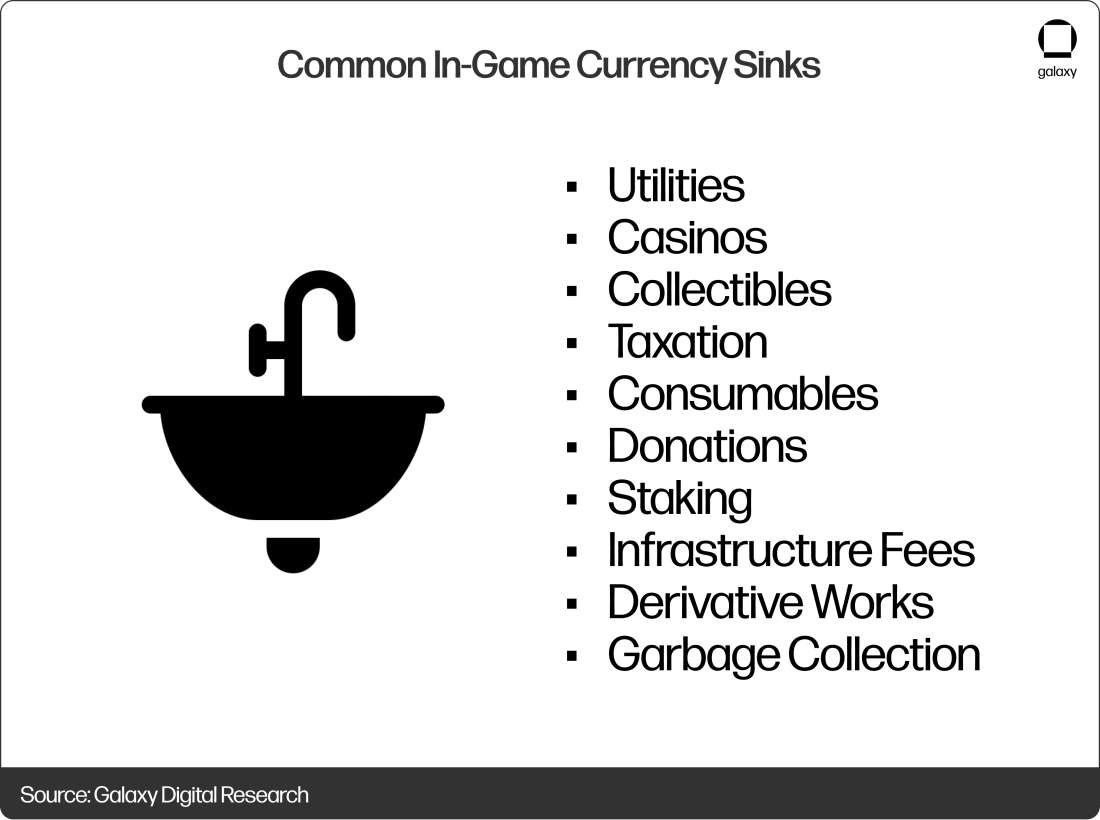
While web3 games have certainly experimented with some of these sinks, untested challenges exist by virtue of building on top of permissionless fungible tokens and NFTs that have liquidity on secondary markets. Players are less incentivized to use sinks when the equivalent USD value of their digital assets is easily measurable. As a result, for a web3 game to successfully implement a sink mechanism, it must be equally clear to the user that there is enough additional utility from using the sink to make up for the notional value lost to the sink. Simply printing more of the staked currency with a time lock is not going to stabilize a web3 economy.
Currency Distancing
Currency distancing is one of the most important aspects of in-game economic design that some (but not all) web3 games also successfully employ. The core tenet of currency distancing is to de-couple the in-game currency from its associated real-world value. Take vbucks (Fortnite) for example. The cost to buy 2,800 vbucks is $19.99. This comes out to 140vbucks for $1. But what can a player do with 140 vbucks?
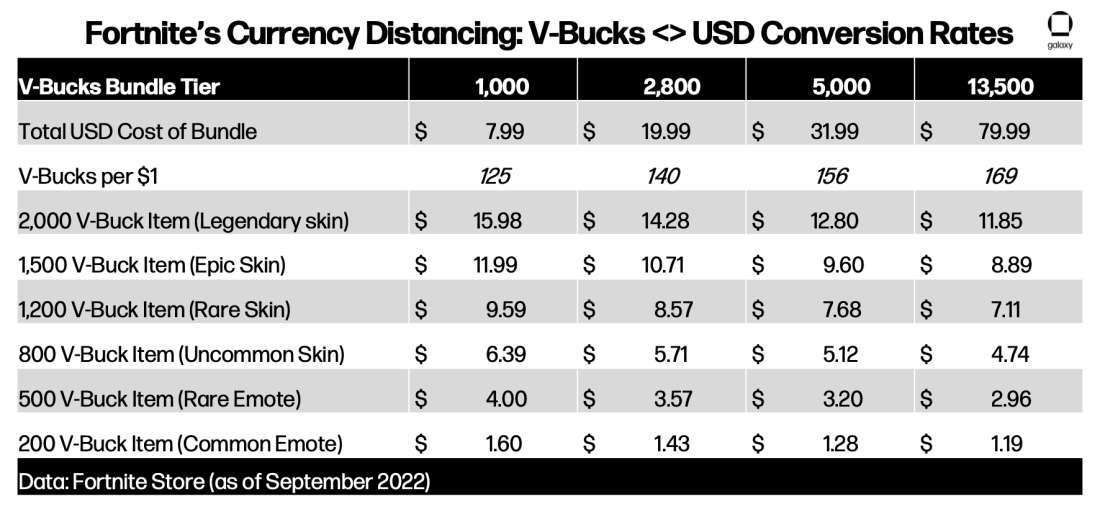
This model is not unique to Fortnite—it exists in almost every microtransaction game that exists today from Candy Crush to Warzone. Currency distancing is important because, as the name implies, it distances in-game economic activity from real-world capital expenditure. If a consumer has a harder time mentally accounting for the cost/benefit of an in-game asset, they are less apt to scrutinize a purchase decision and more apt to spend money in the game. In addition, currency distancing allows developers to sell their in-game currency in predetermined batch amounts (i.e., a consumer can’t buy an exact amount of vbucks to buy a skin, they must buy at least 1,500). This is also intentional as it effectively means that consumers pre-load balances beyond what they would normally pay. A game developer benefits from this due to breakage income, like the gift card business model, and the up-front capital can be leveraged for other company initiatives. From the player’s standpoint, they also succumb to sunk-cost bias where they will be more inclined to purchase additional vBucks to make use of small balances rather than let those balances go unused. Loss aversion is preferred to limited expenditures.
Some of web3’s most powerful features, such as application-agnostic layer 1 tokens and composable DeFi primitives, are at odds with currency distancing. If a game were to leverage an in-game fungible token, consumers could simply swap the exact amounts needed for their digital asset purchase on a DEX. Similarly, to the extent they are fluent in mental accounting with base layer tokens such as BTC and ETH, consumers would be less subject to currency distancing benefits for the developers. Smart web3 game developers that want to maximize economic engagement with players will likely introduce elements from currency distancing as they bake web3 functionality into their gaming applications.
Market Control
Market control can best be thought of as a spectrum that measures the degree to which a game’s economic activity is controlled by the game developer. On one extreme would be total market control which means only the game itself can sell items directly to players. There is no player-player economic activity allowed. Games like Candy Crush and Fortnite employ this model. The benefit of this model is that it successfully will defeat bot farms hoping to extract digital assets from games in a monetization loop. Tightly-controlled markets also ensure developers can modulate digital asset supply issuance at will. However, this model seems to be the least congruent with prevailing web3 ideology as it gives players almost no ability to monetize their in-game efforts outside of the game’s platform. Yet, the highest grossing games have historically employed this economic model.

Partial market control refers to in-game mechanisms that allow players to exchange items either with the game directly or with other players. Games like Runescape have partial market control mechanisms (The Grand Exchange) that essentially act as developer-controller faucets and sinks for in-game items. However, players are typically still able to transact directly with one another, especially for illiquid, grail items (like a Runescape Party Hat). Partial market control mechanisms also allow players to benefit from a better user experience due to the speed and liquidity with which they can trade/exchange low-value, high-usage items (such as consumables used for the construction skill in Runescape).

Finally, free markets represent the other side of the market control spectrum for the economic design of games. Outside of web3, there are no historical examples of a game successfully employing a completely free market. This is because free markets can be easily gamed by astute players who inevitably cause a spike in digital asset issuance with the intention of selling those assets to other players. Left unchecked, free markets can allow economies to fall into a death spiral. Many proponents of GameFi in web3 point to a lack of free markets as a core selling point. However, history indicates that a lack of free markets in games is a feature, not a bug. They are incredibly hard to implement successfully as they introduce layers of complexity that undermine the mechanics of the game itself. One need not look any further than the spectacular rise and fall of games like Axie and STEPN to study the damaging effects of unchecked free markets.
Impulse Buying
Impulse buying boils down to monetizing a gamer’s innate desire to feel like they are in control. Developers of games such as Candy Crush, introduce real-world time constraints to progression (often referred to as choke points), modulating a player’s sense of autonomy. By charging a small fee, that developer is leveraging the cognitive dissonance a player feels when their control is taken away from them to maximize revenue.
Impulse buying is driven by breaks in gaming. These breaks, which can either happen if a player fails to pass a level or if the game forces the player to wait for extraneous events to occur (such as time elapsing), are key to engineering demand for the in-game assets (which are then used to purchase the solution to their break). When a player is in a flow state enjoying a game and their gaming session is suddenly put on-hold, they are much more vulnerable to make an impulse purchase that will allow them to resume their active gaming session. Mobile games like Mobile Strike induce this demand with long build times. Games like League of Legends indirectly induce this demand by making the time commitment to acquire in-game currency for free a massive endeavor compared to purchasing this currency for dollars.
Thus, impulse buying popularized by mobile games has birthed one of the great paradoxes in modern game development: the inclusion of unsatisfying moments that would have historically led gamers of video games to quit the game outright. Instead, these unsatisfying moments have morphed into engineered essentials of the game. Many gamers have derided this “Pay2Win” dynamic as antithetical to the ethos of good game design. Web3 has the potential to challenge this business model with alternate monetization strategies. However, game studios seem to have partially solved for the Pay2Win issue with a different approach towards monetizing in-game assets described in the ensuing sections.
Limited Impact Items
Unlike impulse buying, which focuses on in-game purchases that speed-up or otherwise alter the state of the game at key choke points, limited-impact gratification centers on in-game purchases that have limited impact on the game’s mechanics. Fortnite’s business model is the prime example of this practice with their in-game store that sells purely cosmetic in-game digital assets such as skins, gliders, dances, and emotes. Players appear to be less hostile towards this business model (evidenced by the % of gamers who purchase limited impact items) as it preserves the integrity of the game, and other popular titles like Call of Duty Warzone have implemented similar approaches. With the rise of metaverse applications, we imagine that in-game assets with limited impact but high signaling value, such as a skin in Fortnite, would benefit immensely from permissionless blockchains. This would give the digital item utility outside of the context of the game and perhaps drive additional demand for cosmetic-only items.
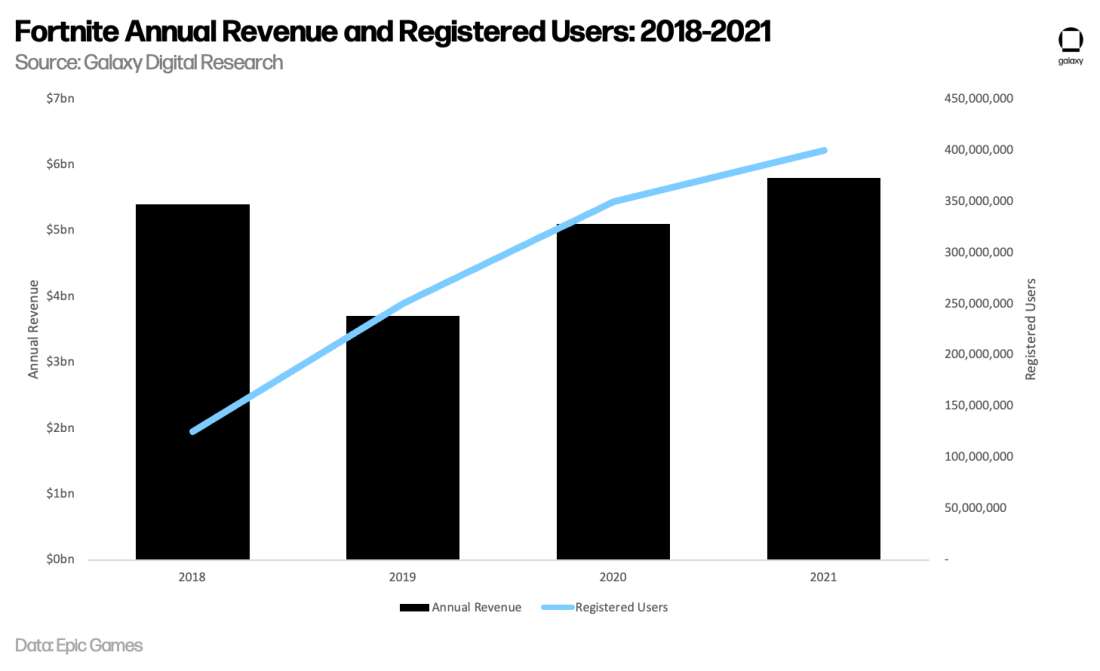
Commodifying Captivity (Prestiging and Battle Passes)
During the 1980s, player achievements were a major incentive for repeat play. Players tried to outdo their personal best scores and join high score lists on arcade games. In an always-on, continuous world of gaming, there is no concept of a singular high-score. Infinity Ward realized this when they were developing Call of Duty 4: Modern Warfare. Released in 2007, CoD4 would go on to be one of the most consequential video games in history. This game, with its addictive multiplayer format, became the de facto standard for top-tier game releases for the next decade (before the Battle Royale genre took the world by storm and innovated on many of concepts first developed by Infinity Ward).
In Call of Duty 4: Modern Warfare, when the player’s character achieves level 55 (the max level), they gain the option to prestige. If the prestige option is selected, all unlocked weapons and perks are removed, so the player must earn them again on a second quest to hit the level 55 cap. Leveling up and the cycle of prestige soothe players with tidbits of individual expression and hierarchal worth in the form of prestige emblems displayed next to the player’s call tag in game lobbies. Achieving 10th prestige in CoD became a right-of-passage for elite players.
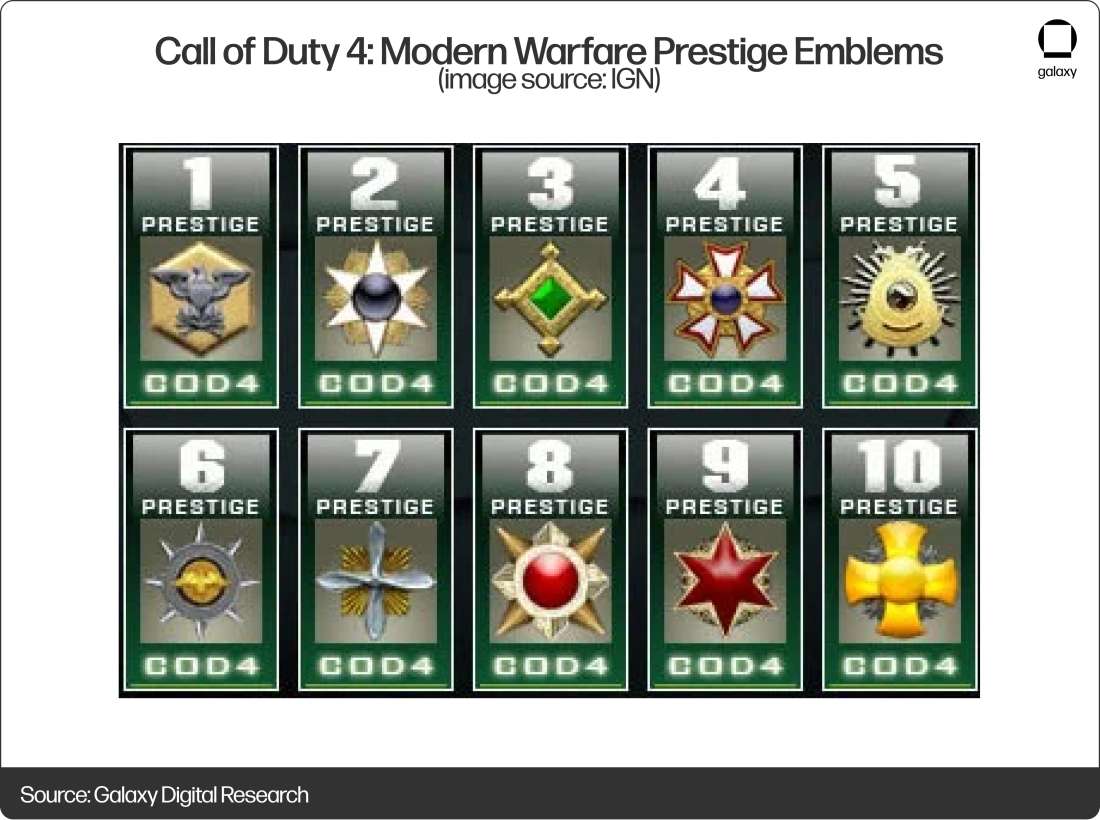
In hindsight, it's easy to see why Infinity Ward pushed the concept of prestiging onto its playerbase. A player's continuous engagement is reduced when a campaign is completed, lowering the potential for additional consumer spending on the game. Infinity Ward flipped this script by instead commodifying a player’s ongoing engagement with the game through online multiplayer to extract the absolute maximum value from players in a seemingly never-ending cycle. In the example of Cod4, players became obsessed with prestiging, which in turn encouraged them to continue playing the same game and spending their money on downloadable content in the form of map packs (rather than a brand-new game). The developer would earn additional revenue long after the initial game was sold to players. Developers also bought themselves more time to produce the next iteration of their AAA title (typically in 2-3 year cycles) such that they could time new releases just as their existing player bases were finally growing tired of their current captivity cycles.
The commodification of captivity has the added benefit of consuming and consolidating any player’s given time spent playing video games into a single game rather than multiple, competing titles. Gone were the days of swapping out multiple paks on a NES in a single night of gaming. Instead, captivity commodification meant that players would spend all their time and attention levelling up their Fortnite or Warzone player and keeping up with all incremental updates made with each Battle Pass season.
Today, games like Fortnite and Warzone commodify captivity with battle pass mechanisms instead of prestige mechanisms. Battle Passes can be thought of as the spiritual successor to Loot Boxes (which endured major scrutiny due to their similarities to gambling) and they were first popularized by Fortnite in 2018 (though they can be traced as far back as Dota in 2013). Like the multiplayer format that dominated Call of Duty games, Fortnite sought to treat the game as an ongoing platform rather than a single, siloed release. Battle Passes, which are purchase by players every season (each season lasts 10-12 weeks) give players tiered access to additional challenges and rewards for continued engagement with the game.
With all these captivity mechanisms driven by in-game economic design, the goal of a videogame developer became singularly focused on keeping players in their own respective games at the expense of other competing games. Game developers understand the importance of keeping a player base inside of a game, and this sentiment is not unique to the gaming industry. Netflix's CEO famously stated on an earnings call in 2018 that Fortnite was their biggest competitor.
Why Play-to-Earn Failed and Where We Go From Here
One of the obvious challenges with creating sustainable web3 games is tokenizing all game assets without sacrificing control of the game’s economy. These challenges are intensified during the early stages of a game’s life when rapid user growth and the ensuing in-game digital asset issuance outpaces the game’s ability to balance supply and demand. Durable game economies often exhibit properties of the Lindy Effect, where old, established games are more likely to have their in-game economies endure in the long-run. Runescape, which has been running for over 20 years, still boasts a healthy economy that has stayed relatively consistent during its entire run. This is evidenced by the real-world value of a Runescape party hat hovering in the mid 4-figures range throughout the game’s lengthy tenure.
An early lesson from web3 games is that liquidity can be both a blessing and a curse. On the one hand, liquidity for in-game assets is good for players because it gives them an avenue to monetize their skills. Even players who simply engage with the game a deep level and develop their own in-game alpha based on their unique insights can be rewarded in an environment of liquid markets. However, liquidity has also turned out to be a breeding ground for users who flood the game for money and detract from the overall experience. We witnessed this dynamic play out most prominently in a couple key web3 games.
Both Axie Infinity and STEPN, once anointed champions for the web3 gaming space and vectors for mainstream crypto adoption, serve as cautionary tales. As seen in the charts below, these platforms witnessed a meteoric rise and fall in a very short period. While the rise of fall of these games is certainly tied to the overall crypto market movements, their game economic design didn’t help. Axie’s economics attracted a glut of mercenary users who simply viewed the game as an opportunity to make money. Although this helped Axie attract new users and generate hype, its permissionless economy also ensured that these mercenary users could dump their positions and exit to the next shiny object. Ultimately, there was nothing compelling about Axie as a game. It operated more similarly to a DeFi yield farming protocol with a thin veil of gaming on top. Once prices started to tumble, Axie’s userbase immediately fled the sinking ship.
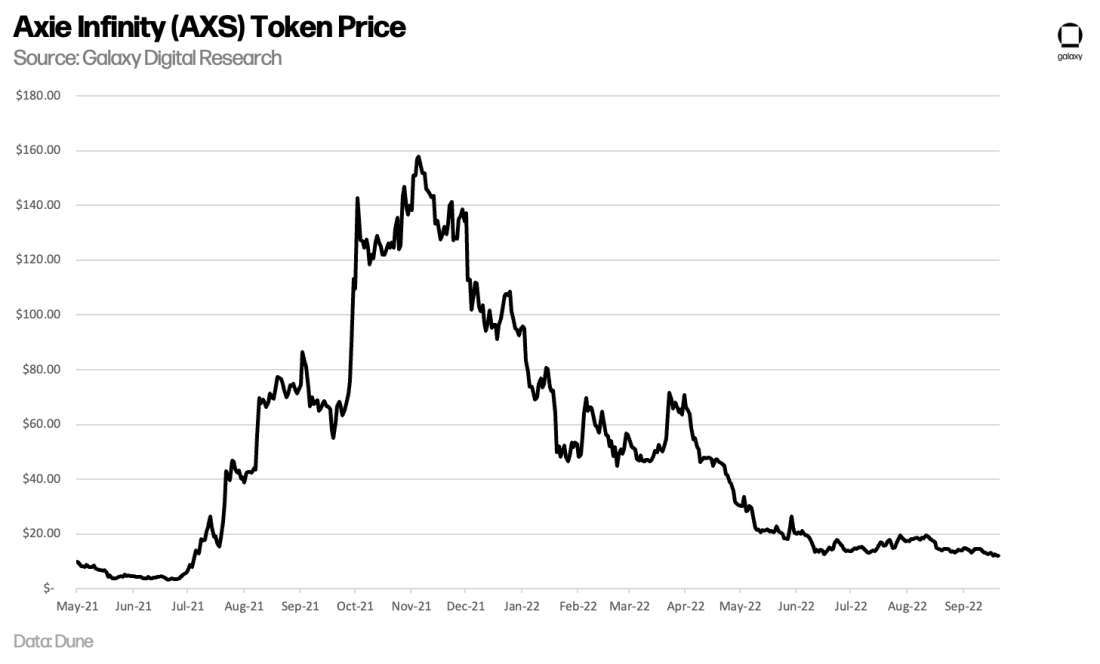
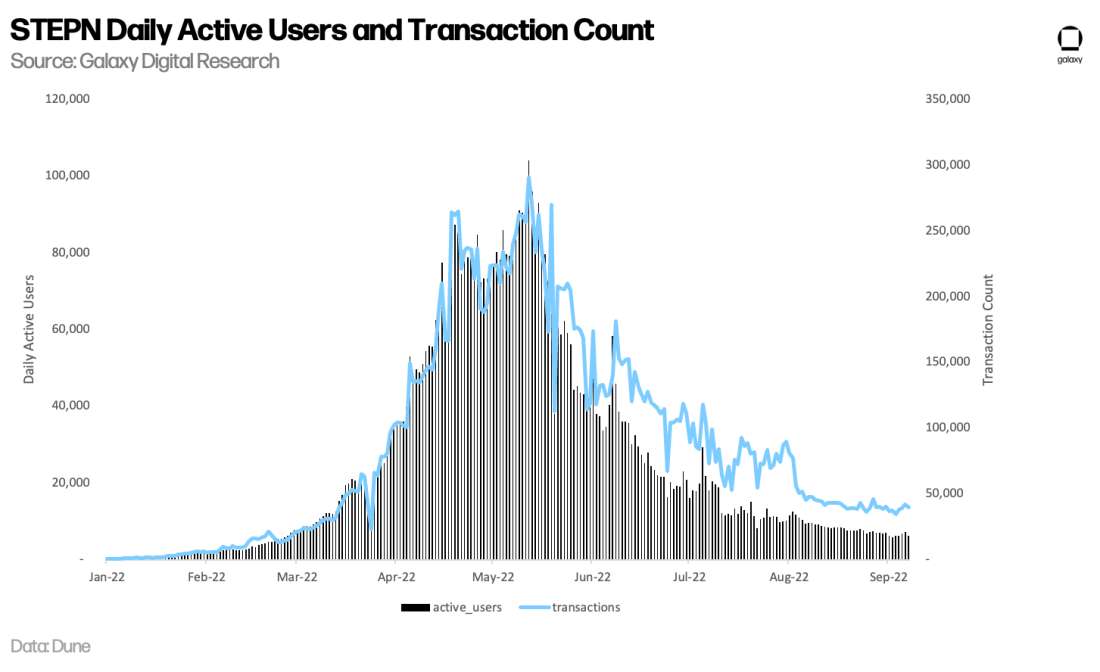
Axie’s proponents would posit that the game failed to maintain a healthy economy because its economy wasn’t fully built out. Had Axie onboarded users at a slower pace and fully built out its feature set, its developers may have been able to properly balance supply and demand for their in-game assets, they argue. Axie failed to learn from decades of cumulative game design knowledge and leveraged few of the battle-tested approaches described in previous sections. The end-result for Axie was a game in name only. What Axie’s developers perhaps failed to internalize is that users don’t play games to get rich (that’s what casinos are for). Rather, users play games to test their skills, typically against other players, and exert autonomy in a game environment where they can connect with others. Users, at some level, expect to escape reality by way of high engagement and flow states. The video game industry didn’t balloon to a $200bn behemoth by dangling prospects of economic prosperity to their respective player bases. In other words, the game needs to be fun, first and foremost. But what does a fun web3 game potentially look like?
One example of a web3 game anchored by a sustainable economy is Sorare’s suite of fantasy sports NFT trading card games (currently available for soccer and the MLB with the NBA on the horizon). The way Sorare’s fantasy game operates is partially inspired by daily fantasy sports leagues (popularized by companies like Draft Kings). Instead of a player creating a league with their friends, players are instead pitted against each other in tournaments with the chance to earn real money (in the form of rare NFTs). However, the game is completely free-to-play as players aren’t betting anything upfront. Instead, players can play in tournaments throughout the season using a mix of cards with varying levels of rarity (rarity impacts a card’s scoring ability). For instance, if a player does well in the 2022 MLB season, all their prior hard work, represented by the rare NFTs they hold, will exist for them next season. Sorare issues NFT trading cards according to the following tiers/scarcities: Common; unlimited (non-purchasable, not an NFT), Limited; 5,000 card NFTs per season, Rare; 1,000 card NFTs per season, Super Rare; 100 card NFTs per season, Unique; 1 card NFT per season (1 of 1). The interesting part of Sorare’s is leveraging fantasy sports, a game design that has engaged millions of fans for decades. Using this proven game design, Sorare then carefully architected the economic underpinnings of their NFT cards to avoid many common pitfalls to which other web3 games have succumbed. We outline some of the interesting game economic design choices they made below:
Completely free-to-play: Any time a new player joins, they are issued 12 or more common cards for free. These cards are not NFTs and do not live on the blockchain. This strategy helps increase the TAM of the player base, which is crucial to onboarding potential whales. It also allows casual gamers or socializers to test the waters before committing capital.
Fixed supply of rare NFTs: As the number of new players increases, the net issuance of in-game digital assets does not change at all. This ensures that each NFT holds its value over time, though it does mean that rare NFTs will become increasingly difficult to obtain as more users join the platform.
No currency distancing: In fact, Sorare doesn’t even have a fungible token that’s used for its games. Instead, Sorare supports purchases of NFTs in USD with a credit/debit card. It appears Sorare is attempting to strike a balance between ease-of-onboarding and proper game economic design. Until web3 becomes more mainstream, it is possible that currency distancing takes a backseat due to the added UI/UX complexity of incorporating fungible tokens.
Use of tournaments for NFT utility: We are very bullish on the use of tournaments to create utility for rare NFTs, which is the entire premise of Sorare’s fantasy sports NFT game. A player must work their way up the ladder to unlock higher-level tournaments that require rarer NFTs to compete. By allowing players to compete against others for valuable NFTs, Sorare is coupling NFT utility with a player’s level of engagement and enthusiasm to play at a high level. These engaged players also happen to be the most monetizable for the developer. This mechanic also keeps mercenary players looking to make a quick buck at bay.
Partial market control: Players can buy and sell their NFT trading cards on both Sorare’s marketplace and any Ethereum-based NFT marketplace like OpenSea. Although Sorare’s marketplace doesn’t implement any visible sinks in the form of fees, they have the option to do so at a later point if needed. However, their conservative approach to asset issuance likely precludes the need to do so.
Captivity commodification mechanism: While Sorare is allowing players to carry their rare NFTs into the ensuing season, the stats players accumulate for each NFT will reset each season. This model, popularized by prestiging and battle passes in successful games over the last decade, helps keep players engaged with Sorare’s platform at the expense of other potential competitors. We think other web3 games will find ways to incorporate this powerful mechanic given its track record of success in AAA titles such as Call of Duty.
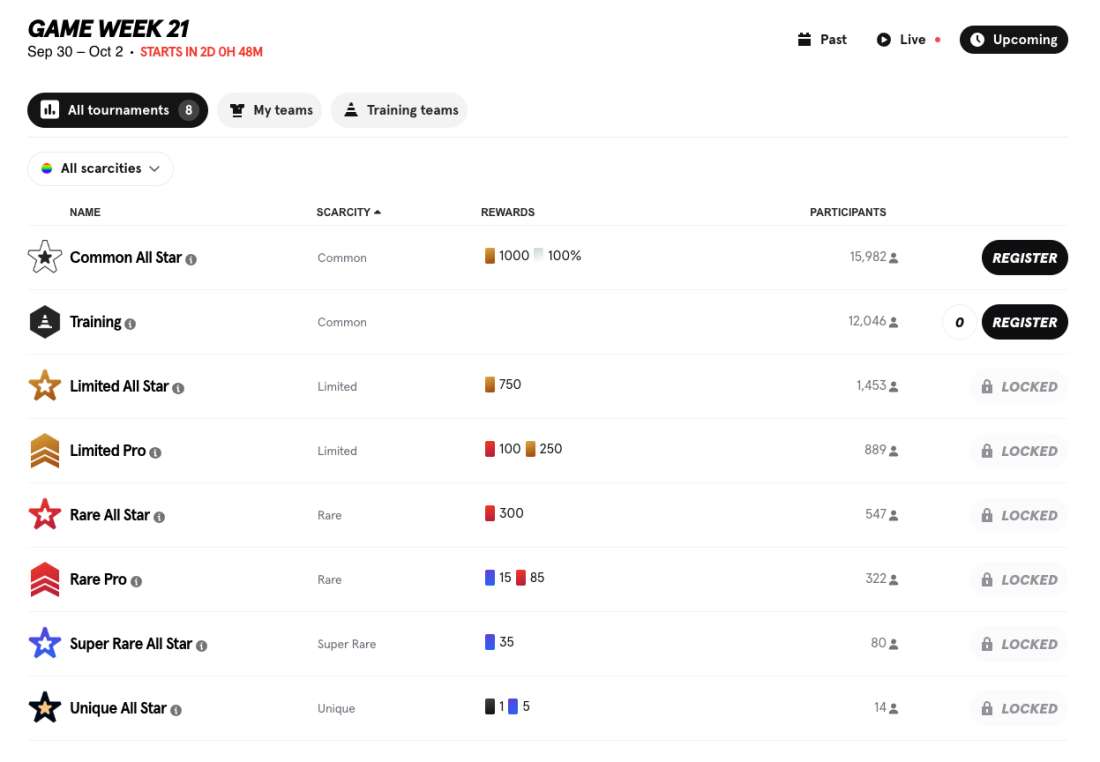
Conclusion & Outlook
There are many factors to consider when developing a game economy powered by web3. The main goal for web3 game developers should be to produce a great game first, and carefully consider the best monetization mechanisms that are congruent with the dynamics of their game before introducing permissionless web3 primitives like NFTs and fungible tokens. One of the key pitfalls we’ve observed in the web3 gaming space is the introduction of web3 economic features too early in the player’s lifecycle. The most profitable games throughout history reached massive levels of adoption by enticing players first with compelling gameplay that is completely free to play. Over-optimizing for web3 features with permissionless NFTs and fungible tokens attracts mercenary playerbases that detract from the game’s community.
Great games are architected to maximize the level of engagement with their users, introducing in-game economic features only after the player is already immersed. Durable game economies can balance supply issuance with demand by implementing sinks and faucets and maintaining a healthy level of control over the game’s economy. To that end, we’re most bullish on web3 games that intelligently incorporate web3 features as-needed to augment an already-compelling gaming experience. The reality is, most games, even outside of web3, turn out to be economic failures with fewer than 10% achieving respectable levels of adoption.
Legal Disclosure:
This document, and the information contained herein, has been provided to you by Galaxy Digital Holdings LP and its affiliates (“Galaxy Digital”) solely for informational purposes. This document may not be reproduced or redistributed in whole or in part, in any format, without the express written approval of Galaxy Digital. Neither the information, nor any opinion contained in this document, constitutes an offer to buy or sell, or a solicitation of an offer to buy or sell, any advisory services, securities, futures, options or other financial instruments or to participate in any advisory services or trading strategy. Nothing contained in this document constitutes investment, legal or tax advice or is an endorsementof any of the digital assets or companies mentioned herein. You should make your own investigations and evaluations of the information herein. Any decisions based on information contained in this document are the sole responsibility of the reader. Certain statements in this document reflect Galaxy Digital’s views, estimates, opinions or predictions (which may be based on proprietary models and assumptions, including, in particular, Galaxy Digital’s views on the current and future market for certain digital assets), and there is no guarantee that these views, estimates, opinions or predictions are currently accurate or that they will be ultimately realized. To the extent these assumptions or models are not correct or circumstances change, the actual performance may vary substantially from, and be less than, the estimates included herein. None of Galaxy Digital nor any of its affiliates, shareholders, partners, members, directors, officers, management, employees or representatives makes any representation or warranty, express or implied, as to the accuracy or completeness of any of the information or any other information (whether communicated in written or oral form) transmitted or made available to you. Each of the aforementioned parties expressly disclaims any and all liability relating to or resulting from the use of this information. Certain information contained herein (including financial information) has been obtained from published and non-published sources. Such information has not been independently verified by Galaxy Digital and, Galaxy Digital, does not assume responsibility for the accuracy of such information. Affiliates of Galaxy Digital may have owned or may own investments in some of the digital assets and protocols discussed in this document. Except where otherwise indicated, the information in this document is based on matters as they exist as of the date of preparation and not as of any future date, and will not be updated or otherwise revised to reflect information that subsequently becomes available, or circumstances existing or changes occurring after the date hereof. This document provides links to other Websites that we think might be of interest to you. Please note that when you click on one of these links, you may be moving to a provider’s website that is not associated with Galaxy Digital. These linked sites and their providers are not controlled by us, and we are not responsible for the contents or the proper operation of any linked site. The inclusion of any link does not imply our endorsement or our adoption of the statements therein. We encourage you to read the terms of use and privacy statements of these linked sites as their policies may differ from ours. The foregoing does not constitute a “research report” as defined by FINRA Rule 2241 or a “debt research report” as defined by FINRA Rule 2242 and was not prepared by Galaxy Digital Partners LLC. For all inquiries, please email [email protected]. ©Copyright Galaxy Digital Holdings LP 2022. All rights reserved.



